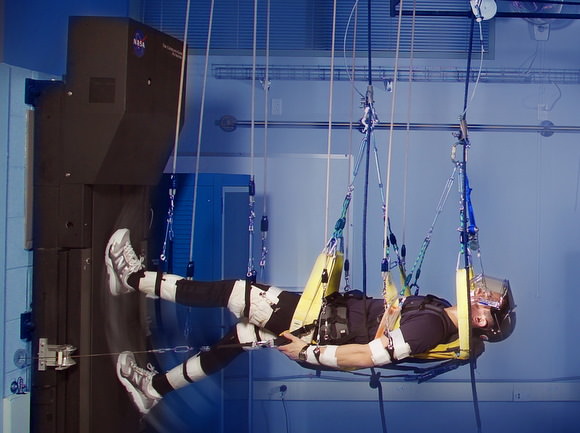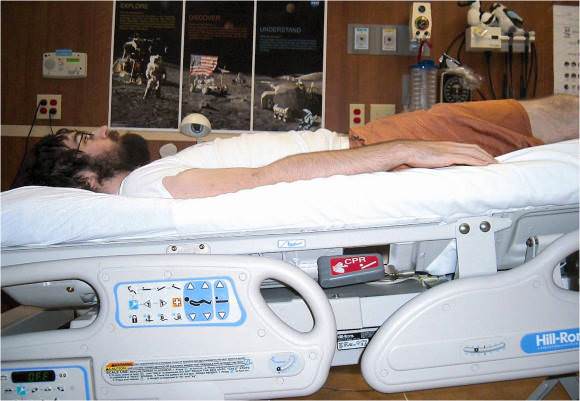

[/caption]
Think it might be fun to live in space? Better ask your bones.
Earth’s space agencies have tackled some of the major obstacles to living in space, with pressurized spacesuits that offset the deadly vacuum and deflect incoming solar and cosmic rays. But in the absence of gravity, astronauts aboard the International Space Station are still losing up to 10 times more bone mass than most Earth-bound post-menopausal women.
In an attempt to address this bone loss, University of Washington researchers found 22 volunteers for a study using bed rest as an analog of spaceflight. The current crop of volunteers are halfway through their commitment to remain in bed, in a six-degree, head-down tilt position for 84 days. The study subjects are still sane, and already, results are promising.


Surprisingly, it’s not necessarily students who are answering the call. Volunteers must be at least 22 years old, so the results apply to the age range of people most likely to be astronauts.
The head-down tilt mimics many of the physiological adaptations astronauts experience during spaceflight, such as bodily fluid shifts toward the head. The bed rest confinement mimics the complete “unloading” of the musculoskeletal system that astronauts feel as they float through space due to the lack of gravity, which accelerates bone loss.
Study leader Peter Cavanagh, a University of Washington professor of orthopaedics and sports medicine, said the volunteers have to be raised to a standing position at the end of their terms very slowly, “because they are very likely to faint” until the heart regains its ability to push blood to the brain. Sometimes, he said, volunteers feel pain in the bottoms of their feet when they finally put them down, and have trouble navigating corners while walking.
“They feel sort of generally weak,” Cavanagh said. “We put them through two weeks of rehab, and we buy them a membership at the health club for another month.”
In that respect, the study volunteers’ experience is similar to that of astronauts returning from long bouts in space. But for half the study subjects, there is a key difference — it’s in their stride.
Half of the study participants perform individually prescribed intermittent treadmill exercise similar to workouts by astronauts in space – but with one important difference: they are pulled towards the treadmill surface by a harness applying greater force than what the research team has previously measured during walking and running on the International Space Station treadmill.
The results from the first half of the study are “extremely promising,” Cavanagh said. Of the five study subjects so far who have been assigned to the exercise group, bone loss in four of them has been prevented in important skeletal regions by the treadmill exercise countermeasure, while the six non-exercising control subject participants all lost bone mass.
“We have found that we can, on average, prevent bone loss in an important region of the hip with this intervention,” Cavanagh said. “No bed rest study ever before has accomplished this.”
Cavanagh said the study results will impact bone health in space by improving exercise prescriptions for astronauts on future space missions. Here on Earth, the work could help scientists understand how individualized exercise programs affect age- and gender-related osteoporosis.
As for the volunteers, the study leaders encourage them to “achieve something special,” Cavanagh said. “Some tried to learn Spanish. We had others who were preparing for exams, and doing things they would have difficulty doing if they led their life with the typical distractions.”
Cavanagh said the study subjects are kept busy with tests during the week, but the weekends can be difficult.
The volunteers make around $8 an hour, but they’re working 24 hours a day.
“One of my most satisfying moments,” Cavanagh said, “is handing them a $12,000 check at the end.”
Source: University of Washington and Peter Cavanagh
Added 3/24: See an interview with study participant Tabitha Garcia at author Anne Minard’s blog.
Could a new, fifth force of nature provide some answers to our biggest questions about…
In 2015, the United Nations adopted the 2030 Agenda for Sustainable Development—the Sustainable Development Goals…
Astronomers have been battling threats to their clear skies on all fronts lately. One of…
If you were Captain of the first USS Enterprise, where would you go!? Humanity is…
Now is the best time to observe Mars in 2025. Mars from 2014. Credit: Paul…
Scheduled for launch in 2027, the Nancy Grace Roman Telescope is slowly being readied for…